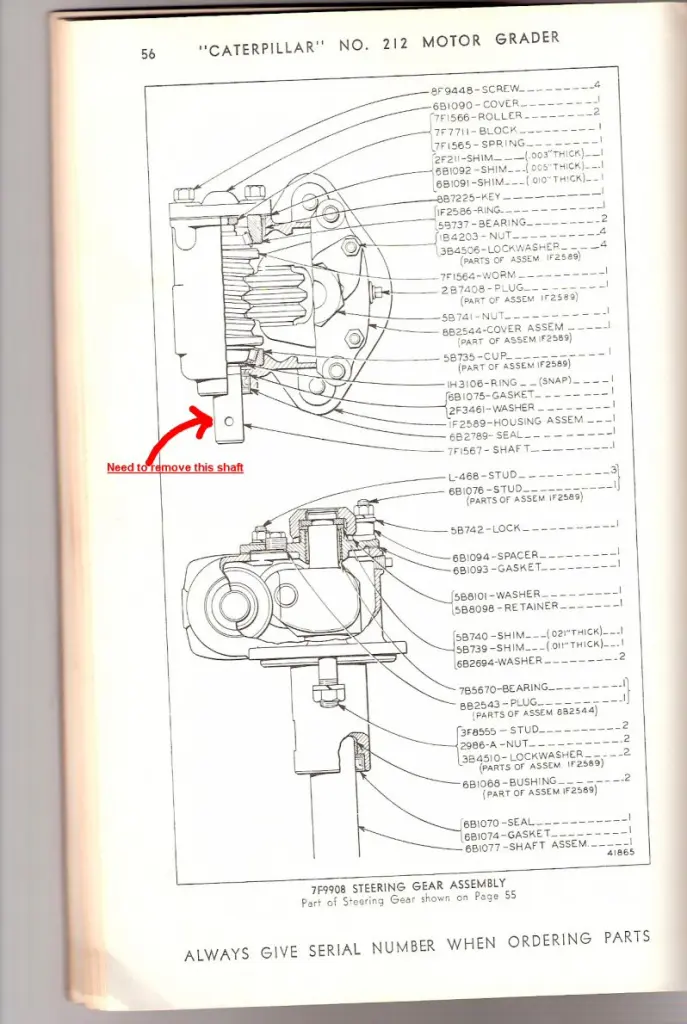What specific questions do you have?
The standard worm/sector steering box is pretty straight forward. About the only tough part is removing the blind end worm bearing race.

Hi OM,
I need to be able to remove the worm gear / shaft. I removed the plate on the forward end; when I move the input shaft, I can see that it's seperate from the actual worm that it turns. If I could simply pull the shaft out, I could make the repairs. However, my parts book says there's a snap ring on the drive end that keeps me from being able to pull it out and I can't see where the snap ring is accessible untile the whole assembly is removed. And I cant't pull the whole assembly out because the drive worm is meshed with the worm for the steering shaft. I know I'm missing something but I need to know how to remove the shaft and/or shaft and worm assembly. I'm asking this in hopes that I don't have to first remove the vertical steering shaft that connects connects to the turn rod.
Thanks Jersey...I was afraid you'd say that. Looks like a pain in the a@#! to remove the arm off the bottom of the shaft. Oh well, if these little repairs were that easy I wouldn't have picked this thing up at the bargain price I did. I knew something was wrong when I picked the grader up and had to put all I had behind the steering wheel to get it to turn. Problem was - no grease which is due to the seal I'm replacing. I've looked everything over closley and the worm gears still look OK though.
ALSO.....maybe you or someone else will know.....what is the extra unused shift lever for on the transmission???(Just curious here) It's located just above where the gear selector box attaches. I remember seeing this lever and it seems like there was at least one more I noticed that was unused. When I was at the Cat dealer I asked and the parts guy looked up the transmission case to see if it would have been used for another machine and the 212 was the only one that came up for that particular transmission case so ...that shot that theory for the extra selector levers. (BTW..CAT said the last time the transmission case was manufactured and available, it's cost was over $4200.00).
Hi Midwest D2,
I read your question as disassembly, didn't realize the box was still mounted.
CC has you covered on that one.
I'm looking at the parts breakdown for a 7F9908 gear assembly but this is on a 112 grader and it does not show a snap ring for the worm. Fairly common to have this type worm drive pressed and keyed to the shaft. When you get the worm out check the bearing race surfaces closely as this is one of the places where they go bad.
I don't have the grader operations manual to check what lubrication is recommended but if it is just gear oil this type gearbox commonly fails from lack of lubrication because the small quantity of oil leaks out. For years, and in all kinds of vehicles I have been using a 50 -50 mix of synthetic 90wt gear oil and synthetic grease. Have never had to rebuild a box since. Do not use straight grease as it tends to channel instead of flow.
Hi Midwest D2,
motor graders with out power steering are notorious for hard steering, almost the first thing I learned about steering a grader was to lean the steer wheels in the direction you wish to turn and bingo you almost have power steering. When roading these things we used to get some weird reactions from car drivers when they saw the front wheels start to lean over as we prepared to negotiate a corner.
Sorry do not have anything to add on the extra trans lever, I have no lit. on these, and cannot remember such a lever, only one I can think of would be out of the selector interlock mechanism, which is connected through the clutch linkage.
Hope this helps.
Cheers,
Eddie B.
Midwest D2,
Are you referring to the dual range shifter ??
If it's like the #12, one lever controls the shifter forks for the lower shaft that has the three forward speeds and reverse. The other controls the forks on the upper shaft dual range gears for high and low range.
Midwest D2,
Are you referring to the dual range shifter ??
If it's like the #12, one lever controls the shifter forks for the lower shaft that has the three forward speeds and reverse. The other controls the forks on the upper shaft dual range gears for high and low range.